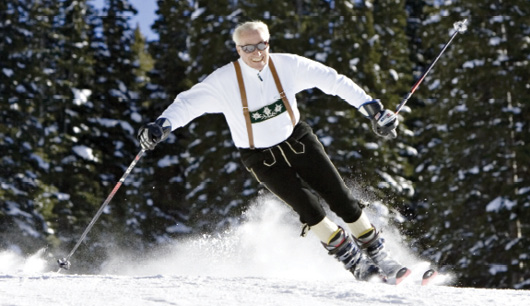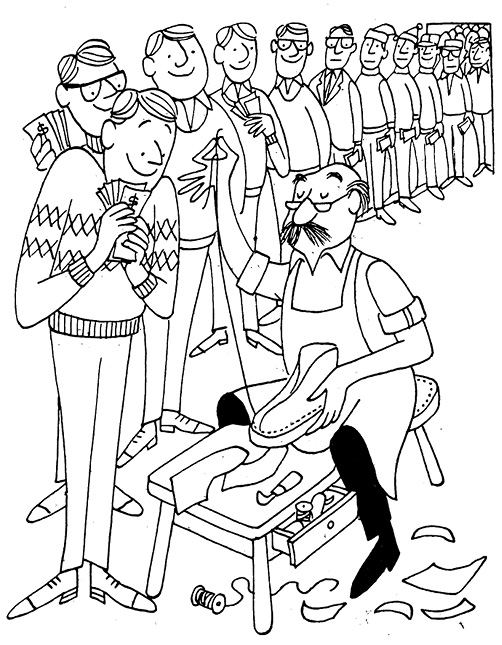ISHA will honor the Swiss Academic Ski Club and the year’s best ski-history books, films and websites in Sun Valley.
The International Skiing History Association (ISHA) will present more than a dozen awards at its 27th annual banquet, to be held March 26 in Sun Valley, Idaho.
The Swiss Academic Ski Club (SAS) will be honored with ISHA’s prestigious Lifetime Achievement Award for more than 90 years of promoting and preserving the history of the sport. Founded in 1924, its wide-ranging mission includes leading the Swiss alpine and nordic university teams, organizing races and events and publishing Der Schneehase, a highly regarded ski-history compendium. SAS Schneehase president Ivan Wagner will travel to Sun Valley from Zurich to accept the award, which focuses on SAS accomplishments in documenting ski history through 39 deeply researched and illustrated editions of Schneehase since 1924. Schneehase president Ivan Wagner will travel from Zurich to accept the prestigious Lifetime Achievement Award on behalf of SAS.
Tickets are on sale now for the ISHA Awards! All ticket holders are eligible for discounted lodging and lift tickets during Skiing History Week in Sun Valley. The jam-packed March 25–28 schedule includes parties, on-mountain events (retro ski day, first tracks, guided tour), history lectures and films, the ISHA Awards (Thursday, March 26) and the U.S. Ski and Snowboard Hall of Fame induction ceremony (Saturday, March 28). For details, go to skiinghistory.org/events.
The evening kicks off at 5:30 pm with a cocktail reception in the Limelight Room at the Sun Valley Inn. Award winners will be on hand to sign and sell books and DVDs. All are welcome; cash bar. The banquet begins at 7 pm for ticket holders only. It’s a lively evening as ISHA Awards chair Rick Moulton and president Seth Masia present entertaining historic video clips and authors offer snippets of insight into their research.
At the banquet, ISHA will also present its Stewardship Award to the Holding family for their decades-long commitment to preserving the history of the Sun Valley ski resort, which they purchased in 1977.
Established in 1993, the ISHA Awards are presented every year to creators of outstanding ski history books, films and DVDs, websites, museum exhibits and other works of creative media. The winners of this year’s ISHA Awards are:
ULLR AWARD
Presented for a single outstanding contribution or several contributions to skiing’s overall historical record in published book form.
Skis in the Art of War by K.B.E.E. Eimeleus. Translation and commentary by William D. Frank, with additional commentary by E. John B. Allen
Skispuren: Internationale Konferenz zur Geschichte des Wintersports (Ski Tracks: International Conference on the History of Winter Sports) by Rudolf Müllner und Christof Thöny, editors. For a review, see the September-October 2019 issue of Skiing History.
Unique and Unknown: The Story of Biathlon in the United States by Arthur Stegen. For a review, see the November-December 2019 issue of Skiing History.
Leisure Cultures and the Making of Modern Ski Resorts, edited by Phillipp Strobl and Aneta Podkalicka. For a review, see the May-June 2019 issue of Skiing History.
SKADE AWARD
Presented for an outstanding work on regional ski history, or for an outstanding work published in book form that is focused in part on ski history.
Heja Persson!: Samisk triumf i Vasaloppet (Sami Triumph in the Vasaloppet) by Isak Lidstrom
Lost Ski Areas of the Berkshires by Jeremy Davis
Honorable Mention: Snowboarding in Southern Vermont: From Burton to the U.S. Open by Brian L. Knight
BALDUR AWARD
A new category of awards presented for books that have not been written as ski histories, but possess valuable historical content.
Ski Inc. 2020 by Chris Diamond with Andy Bigford. For a review, see the November-December 2019 issue of Skiing History.
Alpine Cooking: Recipes and Stories from Europe’s Grand Mountaintops by Meredith Erikson
The Man behind the Maps: Legendary Ski Artist James Niehues by Jason Blevins, with illustrations by Jim Niehues. For a review, see page 30 of this issue.
FILM AWARD
Presented for an outstanding contribution to the historical record of skiing in photographic or film/digital form
North Country, produced by Anthony R. Lahout, written and directed by Nick Martini
Ski Bum: The Warren Miller Story by Patrick Creadon and Christine O’Malley
Honorable Mention: Abandoned by Lio DelPiccolo, Sara Beam Robbins and Grant Robbins. For a review, see the September-October 2019 issue of Skiing History.
CYBER AWARD
Presented for creating a website that contributes substantially to the preservation, distribution and expansion of skiing’s historical record
DrySlopeNews.com by Patrick Thorne
Honorable Mention: From Chimney Corner: An Illustrated History of Slovenian Skiing by Aleš Guček.
MEMBER PROFILE: Klaus Obermeyer
 Klaus Obermeyer, who celebrated his 100th birthday on December 2, 2019, embodies skiing’s history in the 20th century. Klaus was raised in Oberstaufen, Bavaria, hard up against the Austrian border and a jumping site since 1908. At age three he nailed his best shoes to a pair of slats from a fruit crate and took himself skiing. From then on, he’s been tinkering to improve ski gear and clothing.
Klaus Obermeyer, who celebrated his 100th birthday on December 2, 2019, embodies skiing’s history in the 20th century. Klaus was raised in Oberstaufen, Bavaria, hard up against the Austrian border and a jumping site since 1908. At age three he nailed his best shoes to a pair of slats from a fruit crate and took himself skiing. From then on, he’s been tinkering to improve ski gear and clothing.
Klaus was seven years old, and skiing on real skis crafted by Marius Eriksen, when Rudolf Lettner patented the segmented steel edge for skis. When he arrived in St. Anton as a teenaged ski instructor, he quickly found a set of Lettner edges and taught himself enough carpentry to install the edges on his own skis. He befriended St. Anton native and Arlberg-Kandahar champion Friedl Pfeifer, who soon departed for America and eventually the 10th Mountain Division.
One of his skiing students offered Klaus an apprenticeship at Maybach, in Friedrichshafen, just 25 miles from home. The company had been founded, in 1909, to build Zeppelin engines. Klaus assembled state-of-the-art engines for trucks, planes and tanks. Then it was to Neuaubing near Munich and a job designing landing gear for Dornier aircraft (not unlike Howard Head’s career drafting parts for the Martin B-26). At night, Klaus attended engineering school for three and a half years.
Klaus rarely talks about this traumatic era. The Dornier factory in Friedrichshafen was heavily bombed, but not the factory in Neuaubing. Klaus says he was desperate to get out of Germany and tried unsuccessfully to ski into Switzerland.
In 1947 Klaus finally made it to America. There he chased down Friedl Pfeifer and began teaching skiing again. That summer he did odd jobs and painted houses. With Warren Miller, he made and sold Bavarian “kugi” ties. But his technical mind saw ways to improve cold-weather comfort for his students. The first problem was terrible leather ski boots. He improved the standard double-boot design with a comfy cushioned rubber innerboot and had it manufactured by Wagner and Rieker (about 40 miles northwest of Friedrichshafen) under his own label Garmisch. It sold for $44.95. With Pfeifer he formulated and sold a high-altitude sunblock cream. Then he imported sweaters and innovative turtlenecks, Carrera goggles and nylon windshirts.
1955 was a breakthrough year. Klaus adapted the down parka (marketed to hunters since 1935 by Eddie Bauer) for skiers, using water- and windproof nylon fabric, and patented the first “flow” material for ski boots (“It was auto grease,” he confided in 1982). In 1967 he set up a production line to manufacture Bob Smith’s double-lens goggle, imported Sanmarco ski boots beginning in 1972, and introduced the first two-prong ski brake, long before major binding companies picked up the idea. Meanwhile, sales of colorful, comfortable skiwear designs by wife Nome grew, becoming the premier American skiwear brand by the early ‘70s.
Klaus still comes to the office daily, still skis, swims and rides his horses. “I really love Skiing History,” he says. “It’s so nice to have a publication that talks about the development of skiing, how it started and grew in America and worldwide. I love to read it, and to see pictures of my old friends!” —Seth Masia
Send It to a Friend
The best way to recruit a new ISHA member is to show them a copy of Skiing History. This is important because, as a nonprofit, we rely on on membership dues and donations to publish our colorful bimonthly journal, continually expand our website as a global resource for skiers and researchers, and present our annual awards.
Here’s an easy way to help us out: If you know someone who’s a likely prospect, we’ll send them a free one-time copy of Skiing History. Submit your request online at https://skiinghistory.org/send-friend-trial-membership. We’ll take it from there!
SKI LIFE

from SKIING / OCTOBER 1966
This article first ran in the January-February issue of Skiing History.